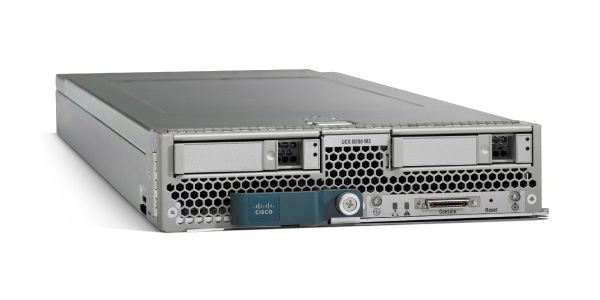Offer details
Related Products
Description
The Cisco® Unified Computing System™ (Cisco UCS™) combines Cisco UCS B-Series Blade Servers and C-Series Rack Servers with networking and storage access in a single converged system that simplifies management and delivers greater cost efficiency and agility with increased visibility and control. The Cisco UCS B200 M3 Blade Server delivers performance, versatility, and density without compromise. It addresses the broadest set of workloads, from IT and web infrastructure, through distributed database. The enterprise-class Cisco UCS B200 M3 Blade Server further extends the capabilities of the Cisco UCS portfolio in a half-width blade form factor. The Cisco UCS B200 M3 harnesses the power of the latest Intel® Xeon® processor E5-2600 and E5-2600 v2 product families, with up to 768 GB of RAM (using 32-GB DIMMs), two disk drives, and up to dual 4x 10 Gigabit Ethernet throughput. In addition, Cisco UCS has the architectural advantage of not having to power and cool excess switches in each blade chassis. With a larger power budget per blade server, Cisco can design uncompromised expandability and capabilities in its blade servers, as evidenced by the new Cisco UCS B200 M3, with its leading memory slot and drive capacity.
The Cisco UCS B200 M3 provides:
- One or two, multi-core, Intel® Xeon® processor E5-2600 and E5-2600 v2 product families CPUs, for up to 24 processing cores
- 24 DIMM slots for industry-standard double-data-rate 3 (DDR3) memory running up to 1866 MHz and up to 768 GB of total memory (using 32-GB DIMMs)
- Two optional, hot-pluggable SAS or SATA hard disk drives (HDDs) or solid-state drives (SSDs)
- Industry-leading 80 Gbps throughput bandwidth
- Remote management through a Cisco Integrated Management Controller (CIMC) that implements policy established in Cisco UCS Manager
- Out-of-band access by remote keyboard, video, and mouse (KVM) device, Secure Shell (SSH) Protocol, and virtual media (vMedia) as well as the Intelligent Platform Management Interface (IPMI)
In addition, the Cisco UCS B200 M3 is a half-width blade (Figure 1). Up to eight of these high-density, two-socket blade servers can reside in the 6RU Cisco UCS 5108 Blade Server Chassis, offering one of the highest densities of servers per rack unit in the industry.
Another Cisco innovation, the Cisco UCS Virtual Interface Card (VIC) 1240 is a 4-port 10 Gigabit Ethernet, Fibre Channel over Ethernet (FCoE)-capable modular LAN on motherboard (LOM) designed exclusively for the M3 generation of Cisco UCS B-Series Blade Servers. When used in combination with an optional I/O expander, the Cisco UCS VIC 1240 capabilities can be expanded up to eight ports of 10 Gigabit Ethernet. The Cisco UCS VIC 1240 enables a policy-based, stateless, agile server infrastructure that can present up to 256 PCI Express (PCIe) standards-compliant interfaces to the host that can be dynamically configured as either network interface cards (NICs) or host bus adapters (HBAs). In addition, the Cisco UCS VIC 1240 supports Cisco® Data Center Virtual Machine Fabric Extender (VM-FEX) technology, which extends the Cisco UCS fabric interconnect ports to virtual machines, simplifying server virtualization deployment.
The Cisco UCS B200 M3 provides:
- One or two, multi-core, Intel® Xeon® processor E5-2600 and E5-2600 v2 product families CPUs, for up to 24 processing cores
- 24 DIMM slots for industry-standard double-data-rate 3 (DDR3) memory running up to 1866 MHz and up to 768 GB of total memory (using 32-GB DIMMs)
- Two optional, hot-pluggable SAS or SATA hard disk drives (HDDs) or solid-state drives (SSDs)
- Industry-leading 80 Gbps throughput bandwidth
- Remote management through a Cisco Integrated Management Controller (CIMC) that implements policy established in Cisco UCS Manager
- Out-of-band access by remote keyboard, video, and mouse (KVM) device, Secure Shell (SSH) Protocol, and virtual media (vMedia) as well as the Intelligent Platform Management Interface (IPMI)
In addition, the Cisco UCS B200 M3 is a half-width blade (Figure 1). Up to eight of these high-density, two-socket blade servers can reside in the 6RU Cisco UCS 5108 Blade Server Chassis, offering one of the highest densities of servers per rack unit in the industry.
Another Cisco innovation, the Cisco UCS Virtual Interface Card (VIC) 1240 is a 4-port 10 Gigabit Ethernet, Fibre Channel over Ethernet (FCoE)-capable modular LAN on motherboard (LOM) designed exclusively for the M3 generation of Cisco UCS B-Series Blade Servers. When used in combination with an optional I/O expander, the Cisco UCS VIC 1240 capabilities can be expanded up to eight ports of 10 Gigabit Ethernet. The Cisco UCS VIC 1240 enables a policy-based, stateless, agile server infrastructure that can present up to 256 PCI Express (PCIe) standards-compliant interfaces to the host that can be dynamically configured as either network interface cards (NICs) or host bus adapters (HBAs). In addition, the Cisco UCS VIC 1240 supports Cisco® Data Center Virtual Machine Fabric Extender (VM-FEX) technology, which extends the Cisco UCS fabric interconnect ports to virtual machines, simplifying server virtualization deployment.
Specifications
| Processor | |
|---|---|
| Thermal Monitoring Technologies | Yes |
| Thermal Design Power (TDP) | 95 W |
| Tcase | 75 °C |
| Supported instruction sets | AVX |
| Scalability | 2S |
| Processor threads | 16 |
| Processor package size | 52.5 x 51 mm |
| Processor operating modes | 64-bit |
| Processor lithography | 22 nm |
| Processor codename | Ivy Bridge EP |
| Physical Address Extension (PAE) | 46 bit |
| PCI Express configurations | x4, x8, x16 |
| Number of QPI links | 2 |
| Memory types supported by processor | DDR3-SDRAM |
| Memory clock speeds supported by processor | 800,1066,1333,1600 MHz |
| Memory channels supported by processor | Quad |
| Memory bandwidth supported by processor (max) | 51.2 GB/s |
| Maximum number of PCI Express lanes | 40 |
| Maximum internal memory supported by processor | 768 GB |
| Idle States | Yes |
| FSB Parity | No |
| Execute Disable Bit | Yes |
| Embedded options available | Yes |
| ECC supported by processor | Yes |
| Bus type | QPI |
| Processor cache type | Smart Cache |
| Processor cache | 20 MB |
| Conflict-Free processor | No |
| Processor series | Intel Xeon E5-2600 v2 |
| Processor frequency | 2 GHz |
| Processor boost frequency | 2.5 GHz |
| Number of processors installed | 2 |
| Processor model | E5-2640V2 |
| System bus rate | 7.2 GT/s |
| Processor socket | LGA 2011 (Socket R) |
| Processor cores | 8 |
| Processor manufacturer | Intel |
| Intelligent Platform Management Interface (IPMI) support | Yes |
| Processor family | Intel® Xeon® E5 Family |
| Memory | |
| Internal memory | 128 GB |
| Memory layout (slots x size) | 8 x 16 GB |
| Memory slots | 24 |
| Memory clock speed | 1866 MHz |
| Maximum internal memory | 768 GB |
| Internal memory type | DDR3-SDRAM |
| ECC | Yes |
| Storage | |
| Supported storage drive interfaces | SAS, Serial ATA |
| Card reader integrated | Yes |
| Compatible memory cards | SD |
| Hot-swap | Yes |
| Supported HDD sizes | 2.5" |
| RAID support | Yes |
| RAID levels | 0, 1 |
| Optical drive type | No |
| Number of HDDs supported | 2 |
| Maximum storage capacity | 2 TB |
| Hot-Plug support | Yes |
| Network | |
| Ethernet LAN | Yes |
| Ethernet interface type | 10 Gigabit |
| Cabling technology | 10/100/1000Base-T(X) |
| Ports & interfaces | |
| Ethernet LAN (RJ-45) ports | 4 |
| Expansion slots | |
| PCI Express slots version | 3.0 |
| Optical drive | |
| Optical drive type | No |
| Design | |
| Rack mounting | Yes |
| Optical drive type | No |
| Chassis type | Blade |
| Performance | |
| Operating system installed | No |
| Intelligent Platform Management Interface (IPMI) support | Yes |
| Display | |
| Built-in display | No |
| Software | |
| Operating system installed | No |
| Processor special features | |
| Intel® Wireless Display (Intel® WiDi) | No |
| Intel® Identity Protection Technology (Intel® IPT) | No |
| Enhanced Intel SpeedStep Technology | Yes |
| Intel Virtualization Technology for Directed I/O (VT-d) | Yes |
| Intel® OS Guard | Yes |
| Intel VT-x with Extended Page Tables (EPT) | Yes |
| Intel® Turbo Boost Technology | 2.0 |
| Intel TSX-NI | No |
| Intel Trusted Execution Technology | Yes |
| Intel® Secure Key | Yes |
| Intel® Quick Sync Video Technology | No |
| Intel® My WiFi Technology (Intel® MWT) | No |
| Intel® InTru™ 3D Technology | No |
| Intel® Insider™ | No |
| Intel® Hyper Threading Technology (Intel® HT Technology) | Yes |
| Intel Flex Memory Access | No |
| Intel Enhanced Halt State | Yes |
| Intel Demand Based Switching | Yes |
| Intel® Clear Video Technology for Mobile Internet Devices (Intel CVT for MID) | No |
| Intel Clear Video Technology | No |
| Intel® Clear Video HD Technology (Intel® CVT HD) | No |
| Intel® Anti-Theft Technology (Intel® AT) | No |
| Intel® AES New Instructions (Intel® AES-NI) | Yes |
| Intel 64 | Yes |
| Intel Virtualization Technology (VT-x) | Yes |
| Intel TSX-NI version | 0.00 |
| Intel Secure Key Technology version | 1.00 |
| Intel Identity Protection Technology version | 0.00 |
| Intel FDI Technology | No |
| Intel Dual Display Capable Technology | No |
| Intel Fast Memory Access | No |
| Processor ARK ID | 75267 |
| Intel Rapid Storage Technology | No |
| Intelligent Platform Management Interface (IPMI) support | Yes |
| CPU configuration (max) | 2 |
| Operational conditions | |
| Storage temperature (T-T) | -40 - 65 °C |
| Operating relative humidity (H-H) | 5 - 93% |
| Storage relative humidity (H-H) | 5 - 93% |
| Operating temperature (T-T) | 10 - 35 °C |
| Operating altitude | 0 - 3000 m |
| Non-operating altitude | 3000 - 12000 m |
| Technical details | |
| Intel Virtualization Technology for Directed I/O (VT-d) | Yes |
| Intel Rapid Storage Technology | No |
| Supported HDD sizes | 2.5" |
| Rack mounting | Yes |
| Intelligent Platform Management Interface (IPMI) support | Yes |
| Hot-Plug support | Yes |
| Ethernet interface type | 10 Gigabit |
| CPU configuration (max) | 2 |
| Chassis type | Blade |
| Other features | |
| Built-in display | No |
| CPU configuration (max) | 2 |










